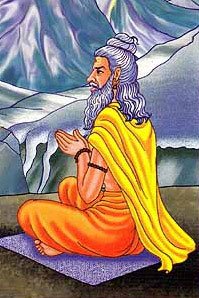Gayatirtha, Gayātīrtha, Gaya-tirtha: 6 definitions
Introduction:
Gayatirtha means something in Hinduism, Sanskrit. If you want to know the exact meaning, history, etymology or English translation of this term then check out the descriptions on this page. Add your comment or reference to a book if you want to contribute to this summary article.
In Hinduism
Purana and Itihasa (epic history)
Source: archive.org: Puranic EncyclopediaGayātīrtha (गयातीर्थ).—The following story is told in the Agni Purāṇa about the origin of this very reputed sacred place at Gayā.
An asura called Gaya was once performing tapas here. As the intensity of his tapas went on increasing, the Devas got nervous and they approached Viṣṇu with the request that he should save them from Gayāsura. Viṣṇu agreed to oblige them. Meantime the intensity of Gaya’s tapas increased daily. Ultimately Viṣṇu appeared to Gaya and as requested by him granted him the boon to the effect that he would become more holy and sanctified than all the tīrthas in the world. (See full article at Story of Gayā-tīrtha from the Puranic encyclopaedia by Vettam Mani)
Source: Cologne Digital Sanskrit Dictionaries: The Purana IndexGayātīrtha (गयातीर्थ).—Origin of; the austerities of Gayāsūra here bearing a stone on his head. Here Gadādhara stood steadfast lest he should move; on this Brahmā performed a sacrifice; shaving and fasting are prescribed in tīrthas but not for this place; measurement 2(1/2) krośa; Gayākṣetram 5 krośas and Gayāśira 1 krośa, the best of all tīrthas.*
- * Vāyu-purāṇa 105. 4-46.
Gayātīrtha (गयातीर्थ) or simply Gayā is the name of a Tīrtha (holy places) mentioned in the 10th century Saurapurāṇa: one of the various Upapurāṇas depicting Śaivism.—[...] According to the Saurapurāṇa (67.19-21) at Gayātīrtha the feet of Śiva is established. Offering of piṇḍas to the manes here is enjoined as it is said to be very efficacious. After bathing in Mahānadī if a person touches the feet of Rudra attains Śivaloka and enjoys with the manes. A good number of Purāṇas contain the glorification of Gayā.

The Purana (पुराण, purāṇas) refers to Sanskrit literature preserving ancient India’s vast cultural history, including historical legends, religious ceremonies, various arts and sciences. The eighteen mahapuranas total over 400,000 shlokas (metrical couplets) and date to at least several centuries BCE.
Languages of India and abroad
Sanskrit dictionary
Source: Cologne Digital Sanskrit Dictionaries: Monier-Williams Sanskrit-English DictionaryGayātīrtha (गयातीर्थ):—[=gayā-tīrtha] [from gayā > gaya] n. Gayā as a renowned place of pilgrimage, [Skanda-purāṇa; Vāyu-purāṇa]
[Sanskrit to German]
Sanskrit, also spelled संस्कृतम् (saṃskṛtam), is an ancient language of India commonly seen as the grandmother of the Indo-European language family (even English!). Closely allied with Prakrit and Pali, Sanskrit is more exhaustive in both grammar and terms and has the most extensive collection of literature in the world, greatly surpassing its sister-languages Greek and Latin.
See also (Relevant definitions)
Partial matches: Gaya, Tirtha.
Full-text: Devashila, Dharmavrita, Dharmavati, Gaya, Gayaparvatam, Shila.
Relevant text
Search found 5 books and stories containing Gayatirtha, Gayātīrtha, Gaya-tirtha, Gayā-tīrtha; (plurals include: Gayatirthas, Gayātīrthas, tirthas, tīrthas). You can also click to the full overview containing English textual excerpts. Below are direct links for the most relevant articles:
Puranic encyclopaedia (by Vettam Mani)
The Skanda Purana (by G. V. Tagare)
Chapter 59 - The Greatness of Gayā Tīrtha < [Section 1 - Avantīkṣetra-māhātmya]
Chapter 92 - Greatness of Aghoreśvara (Aghora-īśvara) < [Section 1 - Prabhāsa-kṣetra-māhātmya]
Chapter 57 - Praise of Gayā Tīrtha < [Section 1 - Avantīkṣetra-māhātmya]
Chaitanya Bhagavata (by Bhumipati Dāsa)
Verse 1.17.30 < [Chapter 17 - The Lord’s Travel to Gayā]
Verse 1.17.32 < [Chapter 17 - The Lord’s Travel to Gayā]
Verse 1.17.142 < [Chapter 17 - The Lord’s Travel to Gayā]
The Padma Purana (by N.A. Deshpande)
Chapter 148 - Mālārka-tīrtha < [Section 6 - Uttara-Khaṇḍa (Concluding Section)]
Chapter 137 - Vikīrṇatīrtha and Śvetodbhava < [Section 6 - Uttara-Khaṇḍa (Concluding Section)]
Chapter 37 - Other Holy Places of Vārāṇasī < [Section 3 - Svarga-khaṇḍa (section on the heavens)]
Vedic influence on the Sun-worship in the Puranas (by Goswami Mitali)
Part 1 - Purāṇic Literature < [Chapter 3 - General Characteristics of the Purāṇic Religion and its Link with the Vedic Tradition]